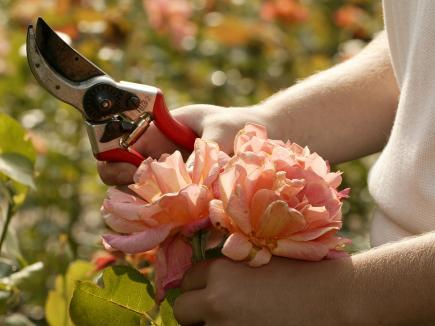 Pruning shrubs and evergreens
Pruning shrubs and evergreensPruning is an essential part of gardening. Correctly pruned trees, shrubs and evergreens will be superior in appearance, vigour and in flowering to neglected plants.
Pruning tools:
Hand held pruning shears
Use for cutting stems up to 13 mm in diameter. Scissor types (illustrated) cut closer than anvil types, which can crush bark if they are not very sharp.
Hedge shears
Use for trimming formal hedges when a neat wall of foliage is the goal.
Lopping shears
Their long handles provide extra leverage, making lopping shears capable of cutting through stems up to 38 mm in diameter.
Tools required
- Hand pruners (secateurs) for stems up to 13 mm in diameter.
- Lopping shears for stems and branches up to 2 cm.
- Hedge shears or electric hedge trimmers for shaping hedges and pyramidal evergreens.
- Pruning saw for larger branches. Cuts over 2 cm should be protected with wound paint or paste.
Pyramidal cedars and junipers may be lightly pruned in early spring to remove any winter-killed tips. By mid-June, it should be apparent that shearing is needed again as the warmer weather produces a rush of growth.
Clip them with hedge shears just like a hedge. No upright evergreen should ever be allowed to outgrow its place in the garden. Spreading evergreens can be similarly sheared or thinned by removing individual branches. Make the cut under an overhanging branch and the pruning will be unseen.
Pruning conifers
Spruce and fir produce buds along the branch. New growth should be removed by about half in the third week of June. This provokes dormant buds to break, creates a more dense foliage canopy and new buds will be set at the cut.
The "leader" of such trees can become disproportionally long and should be cut at this time. Do not cut below the lowest bud or the leader will die back.
Pines do not have buds along the stem, only on the tips. As these buds enlarge in the spring, they are likened to candles. Half of this growth should be removed each year, before the end of June.
Pruning flowering vines and shrubs
These spring flowering shrubs should be pruned immediately after flowering: Caragana, Deutzia, Forsythia, flowering almond, lilac, purpleleaf sandcherry, rhododendron.
In the case of lilac and rhododendron, even if pruning for size is not required, at least remove the spent flowers and prevent the plant from setting seed. This will make them more floriferous next year.
Summer flowering shrubs should be pruned in early spring before growth begins, then pruned again to remove spent flowers. These include roses, pink spireas, Potentilla, butterfly bush, Blue Mist shrub and hydrangea.
Bittersweet vine and shrubs with attractive fruit or berries, some roses, cranberries, etc., offer no best time for pruning. If pruning is required, then do so after flowering, or make use of the decorative berries indoors by cutting the fruited branches — holly berries at Christmas, for example. Spindly Mahonia with bare lower stems should be cut right down in spring.
Most flowering vines such as clematis, honeysuckle, silverlace vine, etc., are extremely vigorous and should be pruned in early spring. Some clematis, Nelly Moser and Duchess of Edinburgh are examples that flower on old wood, then flower again on new growth. If the vine is overgrown, you may have to prune it and forgo early blossom in some years.